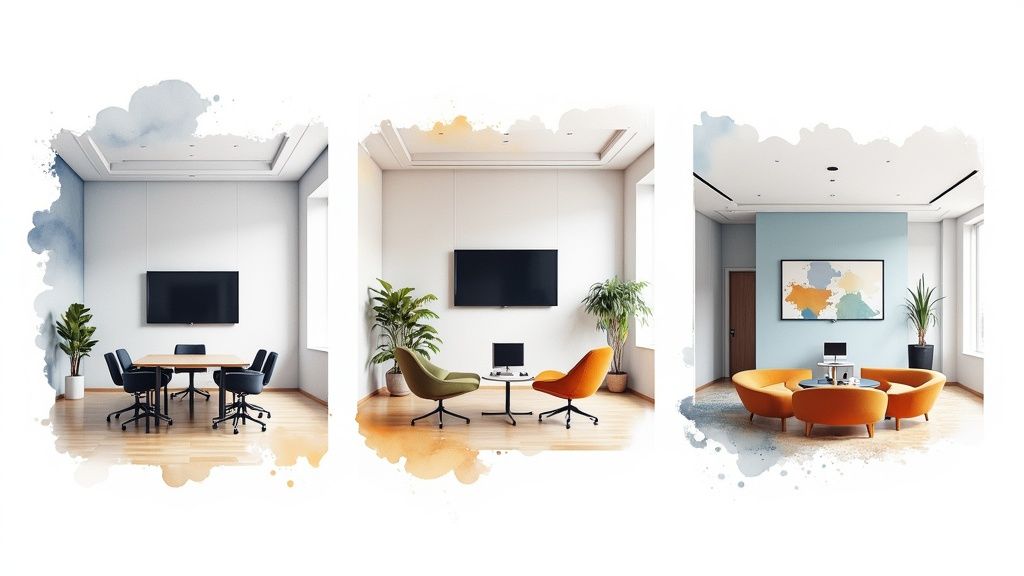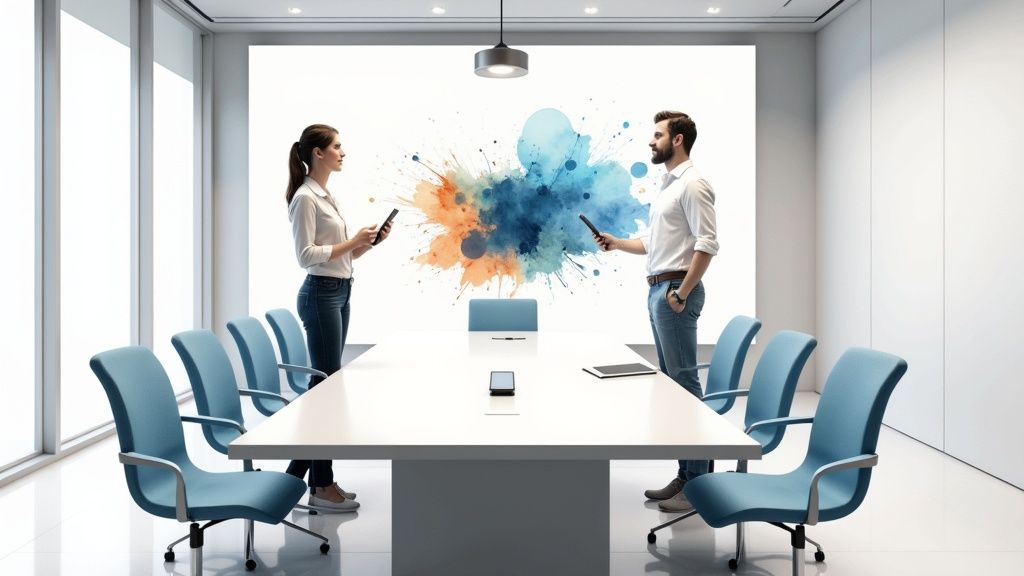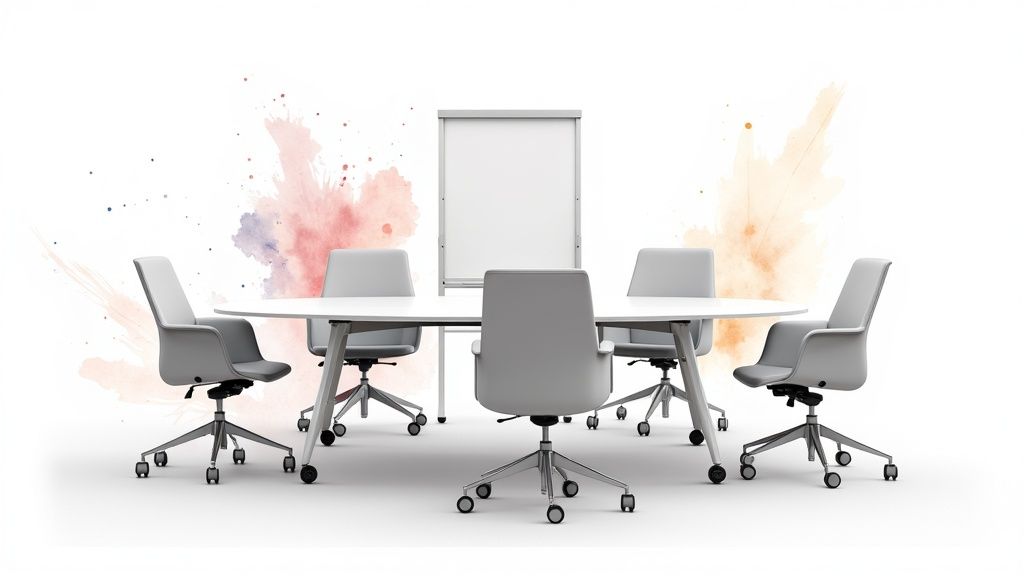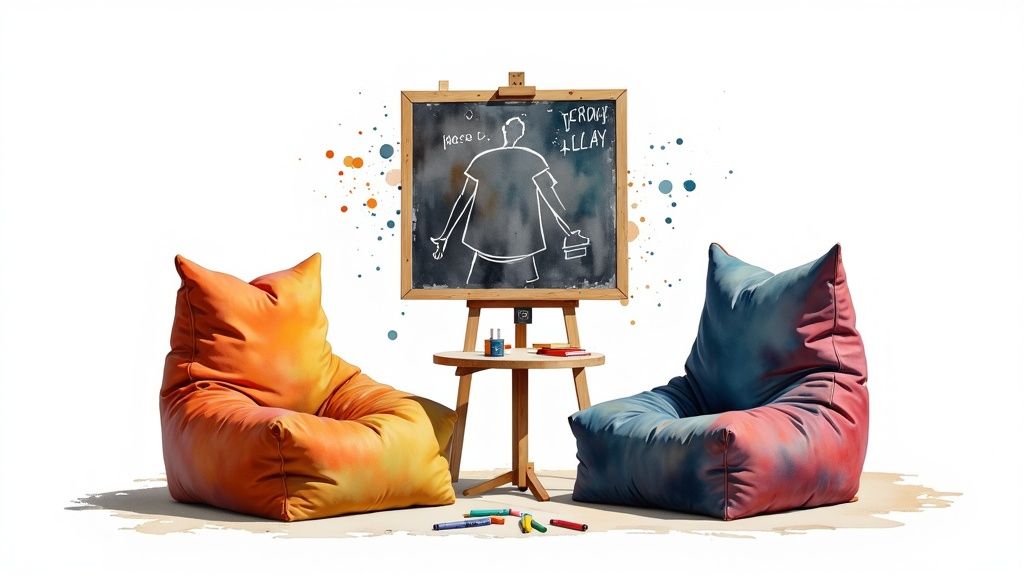9 Inspiring Conference Room Setup Ideas for 2025

The traditional conference room, with its long table, dozen chairs, and a whiteboard, is becoming a relic. In today’s dynamic work environment, a one-size-fits-all approach no longer meets the complex needs of modern teams. The right conference room setup can be a powerful catalyst for innovation, collaboration, and productivity. Whether you’re hosting a high-stakes client pitch, a creative brainstorming session, or a hybrid meeting with a global team, the physical and technological design of your space directly impacts the outcome.
A thoughtfully designed room enhances focus, encourages active participation, and ensures technology works seamlessly. Conversely, an outdated or poorly configured space can stifle creativity, create frustrating technical hurdles, and disengage attendees. This guide moves beyond generic advice to explore nine distinct and actionable conference room setup ideas tailored for the modern workplace. We will provide specific, practical insights you can implement, from layouts that integrate biophilic design to tech-forward hubs that bridge the gap between in-person and remote participants.
Prepare to transform your meeting spaces from simple rooms into strategic assets that support specific goals. Each concept offers a blueprint for creating an environment that not only accommodates a meeting but actively improves it, helping to drive your business forward.
1. Biophilic Design Conference Room
Biophilic design is a powerful conference room setup idea that leverages humanity’s innate connection to nature to create a more productive and calming meeting environment. This approach goes beyond simply adding a potted plant; it involves a holistic integration of natural elements. The core principle, popularized by biologist E.O. Wilson, is that incorporating natural light, living plants, organic textures, and natural patterns can significantly reduce stress, enhance creativity, and improve focus.

This concept is used by innovative companies like Google and Amazon, whose Seattle Spheres are a prime example of biophilic architecture. By bringing the outside in, they create spaces that feel restorative rather than sterile, fostering better collaboration and well-being.
Why It Works
This setup is ideal for meetings that require creative brainstorming, complex problem-solving, or high-stakes negotiations. The calming influence of nature can lower tension and open minds to new ideas, directly combating the fatigue often associated with windowless, artificial environments.
How to Implement It
- Integrate Living Elements: Start with low-maintenance plants like snake plants, ZZ plants, or pothos. For a bolder statement, consider a living wall or strategically placed larger plants that don’t obstruct sightlines.
- Use Natural Materials: Incorporate furniture and decor made from reclaimed wood, bamboo, stone, or cork. These textures add warmth and a tangible connection to the natural world.
- Maximize Natural Light: Position your main conference table to take full advantage of windows. Use sheer window treatments instead of heavy blinds to diffuse light without blocking the view.
- Incorporate Natural Patterns: Think beyond solid colors. Use artwork, rugs, or wallpaper that mimic patterns found in nature, such as leaf veins, water ripples, or wood grain.
2. Technology-Forward Smart Conference Room
A technology-forward smart conference room is a setup idea that integrates cutting-edge tech to streamline communication and enhance collaboration. This concept revolves around creating a seamless experience for both in-person and remote attendees by using interactive displays, wireless presentation systems, and intelligent video conferencing hardware. The goal is to automate functions, reduce setup time, and ensure every participant can contribute effectively, regardless of their location.

This high-tech approach is a hallmark of modern corporate environments, championed by pioneers like Microsoft with its Teams Rooms and Google with its Google Meet hardware. These systems are designed to make advanced technology intuitive and accessible, transforming the meeting from a logistical challenge into a dynamic collaborative session. This design philosophy is central to creating efficient hybrid work models.
Why It Works
This setup is essential for hybrid meetings, client presentations, and data-driven decision-making sessions. The technology ensures remote participants feel fully included with features like AI-powered cameras that frame the active speaker, while interactive whiteboards allow real-time brainstorming. It eliminates friction caused by incompatible cables or complex software, allowing teams to focus entirely on the meeting’s content.
How to Implement It
- Invest in an Integrated Ecosystem: Choose a unified system like Microsoft Teams Rooms, Zoom Rooms, or Cisco Webex. These platforms ensure all components (camera, microphone, display) work together flawlessly.
- Prioritize Wireless Connectivity: Implement a high-quality wireless presentation system (e.g., Barco ClickShare, Mersive Solstice) to allow any participant to share their screen instantly without fumbling with cables.
- Install Intelligent Cameras and Audio: Use cameras with auto-framing and speaker-tracking capabilities. Deploy ceiling or table microphones that capture clear audio from everyone in the room.
- Simplify Control Systems: Use a central touch-panel controller (like a Crestron or Logitech Tap) to manage lighting, shades, displays, and video calls from a single, user-friendly interface. Exploring how AI interior design software can help plan such complex layouts can also be beneficial.
3. Flexible Modular Conference Room
A flexible modular conference room is a highly adaptable setup idea designed for dynamic teams whose needs change from one meeting to the next. Instead of a fixed layout, this concept uses movable, reconfigurable furniture to transform the space for various functions, from a large-group presentation to small-team workshops or a formal boardroom discussion. This approach maximizes space utilization and ensures the room is always perfectly suited for the task at hand.

This concept has been pioneered by furniture giants like Steelcase and Herman Miller, who champion agile work environments. Their mobile tables, modular seating, and lightweight whiteboards allow companies to shift from a theater-style setup to collaborative pods in minutes, reflecting a modern, fluid approach to workplace collaboration. Understanding the principles of space planning is key to implementing such a versatile design effectively.
Why It Works
This setup is perfect for multi-purpose rooms, agile teams, and organizations that host a wide variety of events. It excels in environments where a single room must serve as a training area, a client presentation space, and an internal brainstorming hub. Its adaptability makes it one of the most cost-effective and practical conference room setup ideas for growing businesses.
How to Implement It
- Invest in Mobile Furniture: Select tables, chairs, and whiteboards equipped with high-quality locking casters. This ensures easy movement and stability once arranged.
- Use Modular Seating: Opt for individual chairs or small benches that can be clustered together for group work or arranged in rows for presentations.
- Create Configuration Templates: Design and document several standard layouts (e.g., “Workshop,” “Boardroom,” “Seminar”) to make reconfigurations fast and consistent.
- Incorporate Movable Dividers: For even greater flexibility, consider how you can use temporary walls. There are great guides on maximising space with partitioning systems that can break a large room into smaller, private zones.
- Provide Accessible Storage: Designate a nearby closet or area to store unused furniture neatly, preventing clutter and ensuring components are easy to find.
4. Wellness-Focused Conference Room
A wellness-focused conference room setup prioritizes the physical and mental well-being of participants to enhance productivity and engagement. This approach moves beyond aesthetics to create an environment that actively supports health through ergonomic design, optimized air quality, and mindful amenities. The concept, championed by organizations like the WELL Building Standard and companies like Herman Miller, acknowledges that uncomfortable or unhealthy environments directly hinder focus and collaboration.
Leading companies such as Johnson & Johnson and Patagonia have integrated wellness principles into their office designs. By focusing on human-centric elements, they create meeting spaces that reduce physical strain and mental fatigue, fostering more effective and sustainable collaboration sessions. This design is a strategic investment in employee health and meeting outcomes.
Why It Works
This setup is perfect for long-form meetings, intensive training sessions, or all-day workshops. When participants are physically comfortable and mentally supported, they can maintain high levels of concentration and contribute more effectively over extended periods, preventing the burnout common in traditional, static meeting environments.
How to Implement It
- Invest in Ergonomic Furniture: Choose adjustable chairs with lumbar support and consider sit-stand desks or tables. This allows individuals to customize their posture and stay comfortable.
- Manage Environmental Quality: Ensure excellent ventilation and use air purifiers to maintain clean air. Control the room temperature to a comfortable range, typically between 68-72°F (20-22°C).
- Optimize Lighting: Install circadian lighting systems that mimic natural daylight patterns to support alertness and reduce eye strain. Allow for adjustable light levels for different tasks.
- Provide Healthy Options: Offer filtered water, herbal teas, and nutritious snacks like fruit and nuts instead of sugary drinks and pastries to help maintain energy levels.
5. Creative Collaboration Hub
A Creative Collaboration Hub is a conference room setup idea designed to break away from corporate rigidity and actively foster innovation. This approach transforms a standard meeting room into an informal, dynamic space that encourages brainstorming, open dialogue, and out-of-the-box thinking. The core idea is to create an environment where creativity feels natural, using varied seating, vibrant colors, and accessible tools to spark new ideas.

This concept is famously used by innovation powerhouses like Pixar and IDEO, whose design labs are built for fluid collaboration. By removing the formality of a traditional boardroom, these companies create spaces that prioritize ideation and psychological safety, allowing teams to experiment freely. The right interior design choices are key to achieving this atmosphere.
Why It Works
This setup is perfect for ideation sessions, product development sprints, and marketing strategy meetings. The informal and stimulating environment helps break down hierarchical barriers and encourages participation from everyone, making it ideal for tasks that require a high degree of creativity and collaborative energy.
How to Implement It
- Offer Flexible Seating: Ditch the uniform chairs. Include a mix of comfortable sofas, bean bags, stools, and movable chairs that allow teams to reconfigure the space as needed.
- Provide Creative Tools: Stock the room with an abundance of supplies like whiteboards, large sticky notes, colorful markers, and modeling clay. Make these tools visible and easily accessible.
- Use Color Strategically: Incorporate bright, energizing colors on walls, furniture, or decor. Avoid an overwhelming palette by choosing a few accent colors against a neutral background.
- Install Multiple Writing Surfaces: Use floor-to-ceiling whiteboards, writable glass walls, or even tables with writable surfaces to give teams plenty of space to visualize their ideas.
6. Executive Boardroom
The Executive Boardroom is a classic conference room setup idea that projects an aura of authority, stability, and prestige. This design is not about trendy aesthetics; it’s a deliberate statement of power and professionalism, tailored for high-stakes decision-making. The core principle is to create an environment that commands respect through the use of premium materials, sophisticated technology, and a formal, structured layout that facilitates serious discussion.
This timeless approach is the standard in Fortune 500 corporations, prestigious law firms, and investment banks. The design communicates that the decisions made within its walls are significant and that the organization values tradition and excellence. It is a space designed to impress clients, reassure stakeholders, and empower leadership.
Why It Works
This setup is indispensable for board meetings, critical client negotiations, and high-level executive strategy sessions. The formal atmosphere minimizes distractions and encourages a focused, serious tone. It provides a confidential, secure, and comfortable environment where leaders can deliberate on sensitive matters without interruption, supported by seamless technology.
How to Implement It
- Invest in a Signature Table: The centerpiece is a large, stately conference table made from high-end materials like mahogany, walnut, or marble. Its size and quality should reflect the room’s importance.
- Prioritize Executive Seating: Use high-back, ergonomic leather or premium fabric chairs that offer comfort for long meetings and convey a sense of status.
- Integrate Discrete Technology: Technology should be powerful but hidden. Use pop-up outlets, in-table cable management, motorized screens that retract into the ceiling, and integrated video conferencing systems that blend into the decor.
- Focus on Superior Acoustics: Implement soundproofing materials, acoustic panels disguised as art, and high-quality microphones to ensure every word is heard with perfect clarity, which is crucial for important decisions.
7. Hybrid-Optimized Conference Room
A hybrid-optimized conference room is a purpose-built environment designed to bridge the gap between in-person and remote participants, ensuring an equitable meeting experience for everyone. This forward-thinking setup goes beyond a simple webcam on a monitor; it involves an integrated system of high-quality cameras, advanced audio solutions, and a thoughtful layout. The core goal is to eliminate the feeling of “us vs. them,” making remote attendees feel as present and engaged as those physically in the room.
This model has become the standard for modern global businesses, with companies like Microsoft and Zoom pioneering dedicated “Teams Rooms” and “Zoom Rooms.” These spaces use smart technology to automatically frame active speakers and ensure clear audio, making virtual collaboration seamless and natural. For further insights into optimizing spaces for flexible work, explore strategies for driving change in a hybrid workplace.
Why It Works
This setup is essential for any organization with a distributed workforce. It is perfect for team-wide meetings, client presentations involving remote stakeholders, and cross-functional project collaborations. By providing an equitable platform, it boosts engagement, prevents miscommunication, and ensures all voices, regardless of location, are heard equally.
How to Implement It
- Invest in Smart AV Technology: Use 360-degree cameras or multiple cameras positioned at eye level to capture the entire room naturally. Center-of-table microphones and ceiling-mounted mic arrays help eliminate echo and capture clear audio from every seat.
- Optimize the Layout: Arrange seating so everyone in the room can be seen clearly on camera. A V-shaped or U-shaped table can work better than a long rectangle, as it prevents people from having their backs to a camera.
- Install Large, High-Resolution Displays: Place large screens at the far end of the table so remote participants appear life-sized, fostering a greater sense of presence and connection.
- Ensure Robust Connectivity: A stable, high-speed internet connection is non-negotiable. Consider a dedicated, redundant network for the conference room to prevent drop-offs during critical meetings.
8. Standing Meeting Room
A standing meeting room is a dynamic conference room setup idea designed to foster efficiency and boost energy by removing traditional seating. Built around standing-height tables or counters, this concept is rooted in the idea that physical posture influences mental engagement and meeting duration. The approach, popularized by agile software development teams and forward-thinking tech startups, leverages research showing that standing meetings can be up to 25% shorter and lead to more collaborative, decisive outcomes.
Companies practicing agile methodologies, such as those in software and consulting, utilize these spaces for daily stand-ups and quick huddles. The slight physical discomfort of prolonged standing creates a natural incentive to stay focused, on-topic, and conclude the meeting promptly, making it a powerful tool for productivity.
Why It Works
This setup is ideal for quick check-ins, daily stand-ups, rapid decision-making sessions, and status updates. By encouraging brevity and active participation, it combats meeting fatigue and keeps teams aligned without consuming large blocks of the workday. The increased energy level also stimulates more engaged and creative input from all participants.
How to Implement It
- Choose the Right Furniture: Opt for high-top tables or wall-mounted counters at a comfortable standing height. Ensure there is enough surface area for laptops or notebooks.
- Provide Comfort Options: Place anti-fatigue mats on the floor to reduce strain. Include a few high stools or leaning perches against a wall for team members who may need a brief rest.
- Keep Meetings Short: This format is most effective for meetings under 30 minutes. Use a visible timer to help the team adhere to the intended schedule and maintain focus.
- Optimize for Accessibility: Position whiteboards, displays, and other presentation materials at a height that is easily visible and reachable for someone who is standing.
9. Acoustic-Optimized Conference Room
An acoustic-optimized conference room is a setup designed to control sound, eliminating echo, background noise, and reverberation. This ensures crystal-clear audio for both in-person attendees and remote participants on video calls. This approach goes beyond simply adding a good microphone; it involves a thoughtful selection of materials, furniture, and technology to manage the room’s sound profile.
This concept, pioneered by audio engineering firms and companies like Shure, is crucial for organizations that depend on clear communication. Law firms needing pristine audio for depositions and global corporations relying on seamless international video conferences frequently invest in professional acoustic treatments to prevent miscommunication and enhance professionalism.
Why It Works
This setup is essential for meetings where audio clarity is non-negotiable. It’s perfect for hybrid meetings with remote team members, important client presentations, legal proceedings, or any scenario where every word must be heard perfectly. It reduces listening fatigue and ensures that the message, not the poor audio, is the focus.
How to Implement It
- Incorporate Soft Surfaces: Use acoustic wall panels, thick carpets, and heavy drapes to absorb sound and prevent echo. Upholstered chairs and fabric-covered furniture also contribute significantly to sound dampening.
- Strategically Place Microphones: Install ceiling-mounted or table-integrated microphone arrays that are designed to capture sound from all speakers equally without picking up ambient noise.
- Mind Room Geometry: Avoid parallel hard surfaces (like a glass wall directly opposite a whiteboard) which create “flutter echo.” Angling sound-absorbing panels or using irregularly shaped furniture can break up sound waves.
- Isolate from External Noise: Ensure the room has solid doors, sealed windows, and is located away from high-traffic areas to prevent external sounds from disrupting meetings.
Conference Room Setup Ideas Comparison
| Conference Room Type | Implementation Complexity 🔄 | Resource Requirements ⚡ | Expected Outcomes 📊 | Ideal Use Cases 💡 | Key Advantages ⭐ |
|---|---|---|---|---|---|
| Biophilic Design Conference Room | Medium to High 🔄 | Medium to High ⚡ | Reduced stress, increased creativity 📊 | Creative industries, wellness-focused companies 💡 | Boosts well-being and creativity ⭐ |
| Technology-Forward Smart Conference Room | High 🔄 | High ⚡ | Seamless hybrid meetings, tech-enabled 📊 | Tech companies, enterprises with remote teams 💡 | Enhances remote collaboration and automation ⭐ |
| Flexible Modular Conference Room | Medium 🔄 | Medium ⚡ | Adaptable layouts, efficient space use 📊 | Startups, co-working spaces, training facilities 💡 | Highly flexible and cost-effective ⭐ |
| Wellness-Focused Conference Room | Medium to High 🔄 | Medium to High ⚡ | Improved focus, comfort, reduced fatigue 📊 | Healthcare, wellness-focused orgs, long meetings 💡 | Promotes physical and mental wellness ⭐ |
| Creative Collaboration Hub | Medium 🔄 | Medium ⚡ | Stimulates innovation and participation 📊 | Design agencies, marketing teams, creative industries 💡 | Inspires creativity and engagement ⭐ |
| Executive Boardroom | High 🔄 | High ⚡ | Professional image, authority, privacy 📊 | Executive/board meetings, high-stakes presentations 💡 | Reflects prestige and professionalism ⭐ |
| Hybrid-Optimized Conference Room | Medium to High 🔄 | Medium to High ⚡ | Equal participation hybrid meetings 📊 | Companies with remote workers, global organizations 💡 | Inclusive for remote and in-person attendees ⭐ |
| Standing Meeting Room | Low to Medium 🔄 | Low to Medium ⚡ | Shorter, focused meetings, better posture 📊 | Agile teams, daily standups, quick decision-making 💡 | Encourages active, efficient meetings ⭐ |
| Acoustic-Optimized Conference Room | Medium to High 🔄 | Medium to High ⚡ | Clear audio, reduced fatigue 📊 | Legal, medical, international video conferences 💡 | Superior sound quality and professional feel ⭐ |
Designing Your Next Great Meeting
The journey through these diverse conference room setup ideas reveals a powerful truth: the one-size-fits-all meeting space is a relic of the past. From the nature-infused calm of a Biophilic Design to the seamless connectivity of a Technology-Forward Smart Room, the optimal environment is one that is purpose-built. It’s no longer enough to simply have a table and chairs; today’s most effective meeting spaces are strategic assets designed to drive specific outcomes.
We’ve explored how a Flexible Modular Room can adapt on the fly, how a Wellness-Focused Room can sustain energy and focus, and how a Creative Collaboration Hub can break down hierarchical barriers to spark innovation. Each concept underscores the importance of intentional design. By aligning the physical environment with the meeting’s objective, you create a powerful catalyst for engagement and success.
Key Takeaways for Your Space
To transform your own meeting rooms, focus on these core principles derived from the examples above:
- Purpose Over Preference: Before selecting furniture or technology, define the primary function of the room. Is it for high-stakes executive decisions, creative brainstorming, or seamless hybrid collaboration? Let the intended use guide every choice.
- Human-Centric Design: Prioritize the comfort and well-being of the people using the space. This includes everything from ergonomic seating and good acoustics to proper lighting and air quality. A comfortable participant is an engaged participant.
- Technology as an Enabler: Technology should be intuitive and supportive, not a hurdle. The goal is to make it disappear into the background, facilitating communication for both in-person and remote attendees without friction. This approach is central to effective hybrid setups and aligns with broader facility management best practices that emphasize seamless user experiences.
Your Actionable Next Steps
Embarking on a redesign can feel daunting, but you can start small. Begin by assessing your current meeting spaces. Conduct a simple audit by asking teams what works and what doesn’t. Identify the most common pain points. Is it poor audio for remote team members? A lack of whiteboarding space for brainstorming? A stuffy environment that drains energy?
Use that feedback to choose one or two high-impact conference room setup ideas to pilot. You don’t need to overhaul every room at once. By focusing on a single space, you can test a concept, gather feedback, and demonstrate the value of thoughtful design. This iterative process allows you to learn and adapt, ensuring your investment yields the greatest return in productivity and employee satisfaction. Ultimately, a well-designed conference room is an investment in your company’s most valuable asset: its people and their ideas.
Feeling inspired to reimagine your meeting spaces? Take the guesswork out of design with RoomGenius. Upload a photo of your current conference room and let our AI instantly generate stunning redesigns based on the concepts in this article, helping you visualize the perfect setup before making any changes. Try RoomGenius today and start building the future of collaboration.